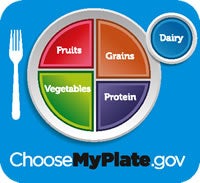Healthy Eating Tips
 Food, Nutrition and Health Tips from the Academy of Nutrition and Dietetics
Food, Nutrition and Health Tips from the Academy of Nutrition and Dietetics
Eat Right with MyPlate
Before you eat, think about what goes on your plate or in your bowl. Foods like vegetables, fruits, whole grains, low-fat dairy products and lean protein foods contain the nutrients you need without too many calories. Over the day, include foods from all the food groups. Try the following tips to "Get Your Plate in Shape."
Make half your plate fruits and vegetables.
- Eat a variety of vegetables, especially dark-green, red and orange vegetables plus beans and peas. Fresh, frozen and canned vegetables all count. Choose "reduced sodium" or "no-salt-added" canned vegetables.
- Add fruit to meals and snacks. Buy fruits that are dried, frozen or canned in water or 100% juice, as well as fresh fruits.
Make at least half your grains whole.
- Choose 100% whole-grain breads, cereals, crackers, pasta and brown rice.
- Check the ingredients list on food packages to find whole-grain foods.
Switch to fat-free or low-fat milk.
- Fat-free and low-fat milk have the same amount of calcium and other essential nutrients as whole milk, but less fat and calories.
- If you are lactose intolerant, try lactose-free milk or a calcium-fortified soy beverage.
Vary your protein choices.
- Eat a variety of foods from the protein food group each week, such as seafood, nuts and beans, as well as lean meat, poultry and eggs.
- Twice a week, make seafood the protein on your plate.
- Keep meat and poultry portions small and lean.
Cut back on sodium and empty calories from solid fats and added sugars.
- Drink water instead of sugary drinks. Select fruit for dessert. Eat sugary desserts less often. Choose 100% fruit juice instead of fruit-flavored drinks.
- Look out for salt (sodium) in foods you buy. Compare sodium in foods and choose those with lower numbers. Add spices or herbs to season food without adding salt.
- Make major sources of saturated fats such as desserts, pizza, cheese, sausages and hot dogs occasional choices, not every day foods.
- Select lean cuts of meat or poultry and fat-free or low-fat milk, yogurt and cheese.
- Switch from solid fats to oils when preparing food.
Enjoy your food but eat less.
- Get your personal daily calorie limit at www.ChooseMyPlate.gov. Keep that number in mind when deciding what to eat.
- Avoid oversized portions. Use a smaller plate, bowl and glass.
- Cook more often at home, where you are in control of what's in your food.
- When eating out, choose lower calorie menu options. Choose dishes that include vegetables, fruits and whole grains.
- Write down what you eat to keep track of how much you eat.
- If you drink alcoholic beverages, do so sensibly. Limit to 1 drink a day for women or to 2 drinks a day for men.
Be physically active your way.
- Pick activities that you like and start by doing what you can, at least 10 minutes at a time. Every bit adds up and health benefits increase as you spend more time being active.
- Children and teens: Get 60 minutes or more a day.
- Adults: Get 2 hours and 30 minutes or more a week of activity that requires moderate effort such as brisk walking.
For more healthy eating tips, visit www.eatright.org.










